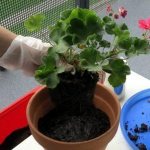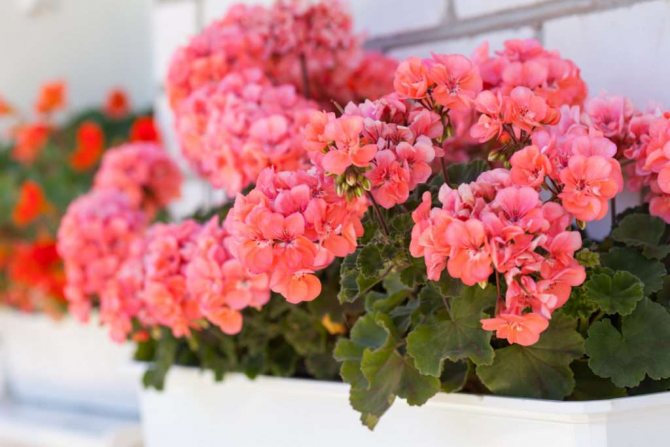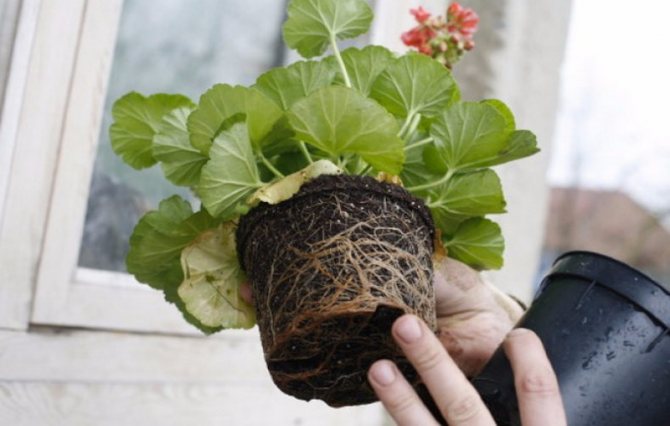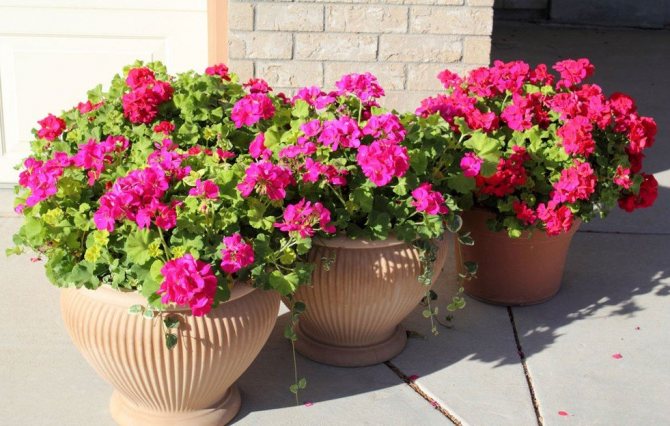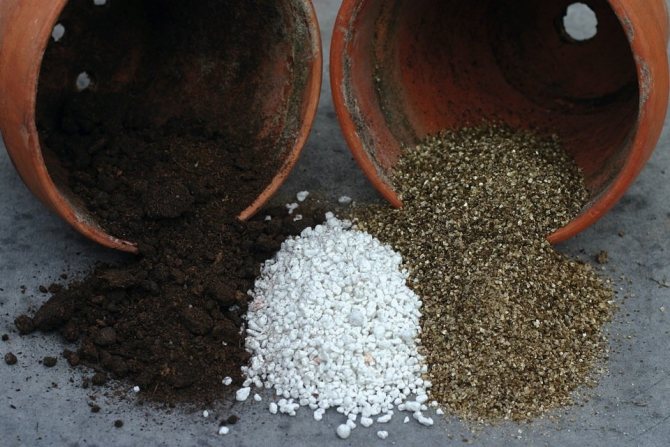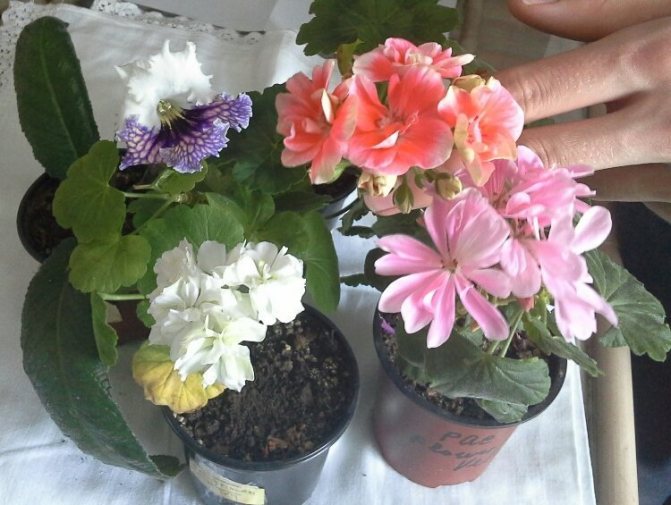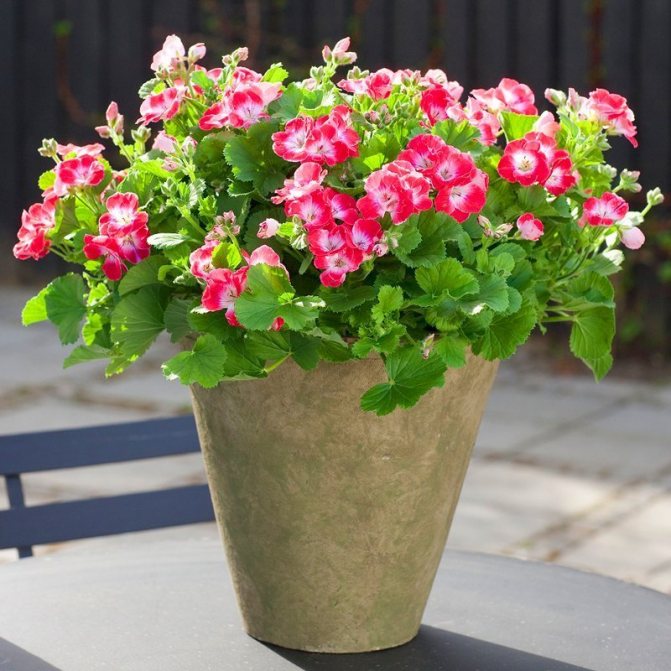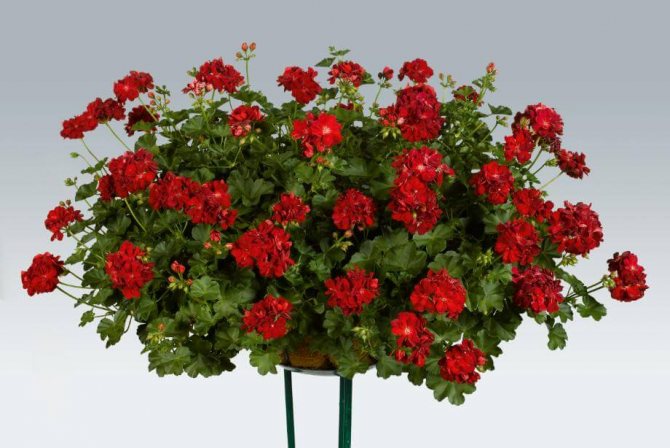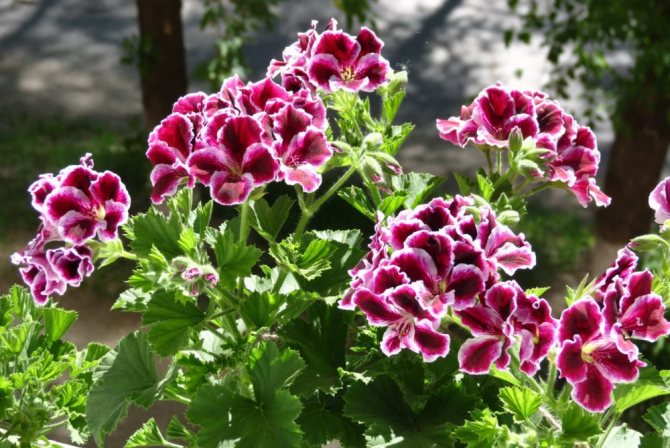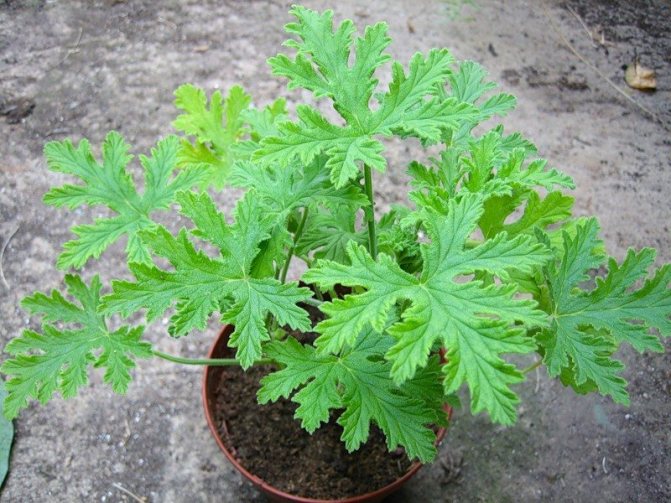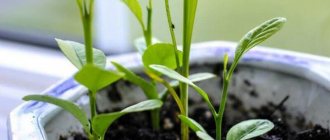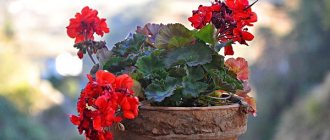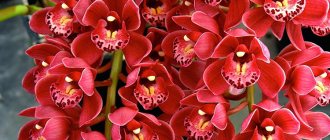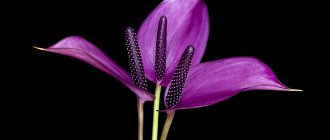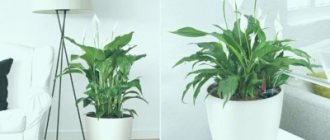Reasons for transplant
ATTENTION: For any flower there comes a time when it needs a transplant.
Let's take a look at the reasons for geraniums:

The pot became small for the plant. Roots began to appear from the drainage holes, you began to water geraniums more often. The appearance of yellow leaves is also possible.- Decay of roots.
- Unsuitable soil. You have noticed that the geranium has stopped growing, although it is receiving feeding and proper care. This is a clear signal.
- Landing in open ground and vice versa.
Unless there is a good reason to replant the geranium, leave it alone. This plant will feel better in its old place of residence. There will be only problems from an unreasonable move.
Pot size and material
If the transshipment will be carried out due to the fact that geraniums simply become cramped in the old pot, you need to responsibly approach the choice of capacity. The intensity of growth and quality of flowering of pelargonium directly depends on the correctness of this choice. First of all, the container should be slightly larger than the previous pot. Do not choose too large a container, as the flower will grow poorly in it. It will form many shoots that will stop blooming and begin to stretch out. As a result, instead of a flowering plant, you will get an overgrown bush. The new container should be just a couple of centimeters larger in diameter than the old one.
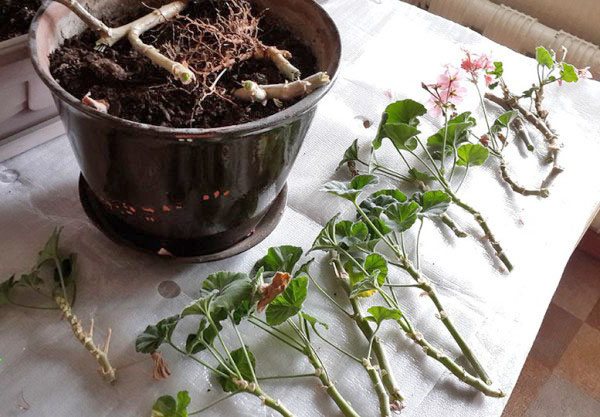

The pot can be either plastic or clay. The plastic is more practical in terms of maintenance, but it impairs the aeration of the roots. Clay containers are prettier and better suited for plants. But it is more difficult to extract flowers from such pots, since the roots are often strongly attached to the inner surface of such a container.
It is important that there are drainage holes at the bottom of the pot through which excess moisture in the ground will be removed.
What periods can you do?
In the spring
The most optimal option. The plant has just woken up from hibernation, and all processes are gradually returning to the same rhythm. You can start a transplant starting in March. It is logical to combine transplantation with planned pruning, division and rejuvenation of the geranium bush... By replanting a flower in spring, you will enjoy its abundant flowering all summer.
In summer
Summer is a period of abundant flowering of geraniums. If, nevertheless, you have a need to disturb the flower, give preference to the first month - June.
In autumn
The change in the location of geraniums in the autumn months is associated, as a rule, with the end of the summer cottage season.... In the open field, geranium feels comfortable until the first frost. Therefore, it is worth thinking about a transfer from mid-October to November, depending on the weather.
In addition to all of the above, at any time of the year, geraniums should be transplanted after purchase.
Can I follow the procedure after purchase?
This cannot be done. The flower has already been transplanted in the nursery, then it probably survived several transportations, staying at transshipment bases and warehouses. Then he went to the store and home to the customer.
Blooming geraniums received a lot of stress. It is considered a huge mistake to replant it immediately after purchase. Rest time is needed, during which the plant gets used to the changed conditions.
Often, flowers purchased in the store die after flowering.At this time, you need to treat them with care, control temperature and humidity, monitor the soil in order to prevent maximum negative external influences.
Algorithm of actions step by step
Pot selection


The key to a healthy appearance, constant growth and abundant flowering of geraniums is an optimal pot size. It will not be difficult for novice gardeners to make a mistake in the range of materials, shapes, colors and volumes. It should be understood that a pot that is small will not allow the roots to develop well, the flower will fade and even fertilizers will not save it.
Planting geraniums in a pot that is too large for them will also not achieve a good result. At first, having noticed the growth of a large number of shoots, you may be mistaken that the flower is comfortable. However, this is not at all the case. When there is too much room in the pot of room geranium, it begins to gain root and side shoots. Which will lead to a long absence of flowering.
Thus, experts recommend opting for a pot of slightly larger diameter than the one in which your beauty was sitting earlier. There is also the option of planting several individuals in one oblong container for placement on a veranda or balcony.In this case, the optimal distance between the bushes is no more than 2-3 cm.
IMPORTANT: An important condition for all geranium pots is good drainage and holes in the bottom.
More information on how to choose a pot for geraniums is described in our material.
Soil selection
Today, the assortment of flower shops includes soils specially formulated taking into account the peculiarities of geraniums. By their structure, they are loose, which is so popular with this type of flowers. However, they will also grow comfortably in the soil from your garden, just add river sand there to create porosity. You can also independently make up a soil mixture of peat, sand, a small amount of wood ash.
To be sure that the resulting soil will definitely please the beautiful geranium, we give the recipe:
- Humus - 2 parts.
- Sod land - 2 parts.
- River sand - 1 part.
Home action plan
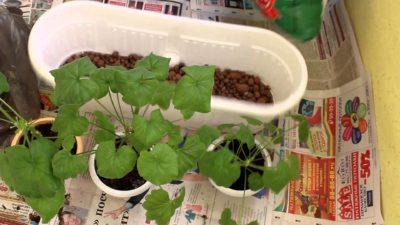

First of all, drainage is laid at the bottom of the pot. They have proven themselves well as drainage: expanded clay, red brick, broken pieces from clay pots. If from all of the above there is nothing, you can take polystyrene torn into small pieces.
The plant is watered abundantly before transplanting for better removal from the pot... Then it is carefully taken out with a lump of earth and transferred to a new pot. The empty edges between the dishes and geraniums are covered with moistened soil until the void disappears. The first watering after transplanting is done on the fourth day.
Watch a video about transplanting geranium (pelargonium) at home:
Growing features


If you chose geranium to decorate your interior or front garden, you were right, because geranium blooms beautifully, often and for a long time, thereby contributing to the creation of coziness in the house and giving freshness and beauty to the garden.
If the location of the flower allows it to receive a sufficient amount of light and sunlight, as well as if it is properly looked after and does not forget to water, then the inflorescences will bloom one after another almost all year round, delighting the hostess with its obedience and responsiveness to proper care.
When and how much does it bloom?
This, undoubtedly, depends on which type of plant you have chosen for yourself. Mostly geraniums bloom from early spring to mid-winter... It also happens that they give inflorescences all year round, without ceasing even in winter.
But how does it work? Of course, a single blossoming flower cannot remain fresh for such a long time as on the first day of its appearance.Sooner or later, it fades, but at the same time other inflorescences bloom, and later a new one will also appear in the place of the lost flower. That is why wilted buds do not spoil the overall picture, and their change occurs imperceptibly. In more detail about when, how and under what conditions geranium blooms, you will find out in this article.
How to properly plant in open ground and return to the premises?
The garden plot is also a favorite spot for your geraniums. Of course, as after the usual procedure of transplanting into a new pot, she will get a little sick. This is manifested in the yellowing of the foliage, possibly dropping. However, do not be discouraged, after a while it will get used to it and take root. Having gained some strength, she will delight you with a long and abundant flowering.
In the open field, the bushes grow much faster and grow more than in indoor conditions in pots.... Geranium is unpretentious in outdoor conditions, however, when choosing a place, you should give preference to partial shade in order to avoid direct sunlight on the leaves. You should also avoid areas with stagnant water, otherwise it is fraught with infection of the plant, for example, "black leg".
We also propose to consider the nuances of the procedure for transplanting geraniums back from the street into a pot. The day before, you need to shed plenty of soil around the plant. After the water is absorbed, you need to carefully dig out the bush along with a large enough lump of earth and transfer it into a pot of a suitable size.
TIP: If the bush has grown and does not fit into its previous pot, you can take cuttings from the plant and grow a new, young plant. Or divide the bush into several and plant them in several pots.
Further, geranium again passes into the category of indoor plants. When transferred from open ground to a house, the death of some of the leaves is a completely natural and inevitable phenomenon.... This is how the plant adapts to new conditions.
Watch a video about transplanting geraniums from open ground into a pot:
The necessary conditions
First of all, in order for the plants of this species to bloom magnificently, it is necessary to properly care for it at the appropriate time of the year:
- Winter is usually a dormant period for her. Therefore, if you want it to please with its flowering in spring and summer, in winter you will have to remove it in a cool place and provide it with light watering.
TIP: If the usual place for this plant in your house is a windowsill, and there is a battery under it, it makes sense in winter to move the pot to another place (away from the battery), for example, to the balcony. - In the spring, geraniums should be transplanted. Why it needs to be done in the spring is explained by the fact that in winter it "sleeps", all processes slow down, and it takes a long time to take root, and sometimes even dies.
In summer, geraniums bloom, and all their strength is spent on the appearance of new inflorescences, so transplanting at this time can also adversely affect the state of the plant. But in early spring, before the buds appear, when she "comes to life", she can best endure changes, including transplantation. - In the summer, it is recommended to find a place for the flower where it will receive plenty of sunlight. In addition, the flowering rate will be favorably influenced by more watering than in winter, but moderate.
But these measures may not be enough for geranium flowering. It will also promote better and longer flowering if you do the following:
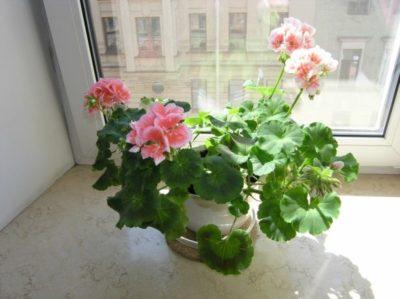

As the flowers dry, remove them in time.- In winter, keep the plant at a temperature of 10-15 degrees on the balcony or on the windowsill closer to the glass.
- Provide adequate lighting, while avoiding direct sunlight, which could burn the leaves.
- In winter, if there is a lack of light, place it under artificial lighting for several hours a day.
If the lighting turns out to be so strong that the geranium gets sunburn, or, on the contrary, is not necessary enough, then it is most likely that it will still bloom. However, not as long and beautiful as it would be with decent care.
Nuances in the case of a flowering bush
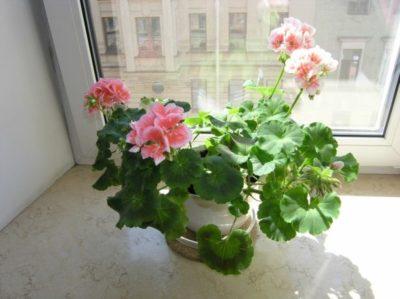

Any plants during flowering spend a lot of energy on bud formation and seed ripening. During such a period, it is better to regret the geranium, to strengthen the feeding, and not to subject it to additional stress (read about how to feed the geranium with iodine and hydrogen peroxide, and from this article you will learn about how to fertilize the plant for lush flowering). Otherwise, the flowers will first fall off, then the leaves will turn yellow. The plant may even die. It is recommended to wait until the end of flowering and transplant indoor geranium in 5-10 days.
If there is an urgent need to transplant geraniums into a new pot at the time of flowering (they dropped or damaged the plant, the bush got sick), then this can still be done. You need to try to transfer the pelargonium into a new container without damaging the roots.without destroying the earthen lump. The flowers, of course, will fall, but the geranium will survive.
Transplant problems: soil composition and others
Pelargonium does not like changing the pot, but still, in most cases, it successfully adapts to a new place. Of course, she can get sick, according to some observations, the habituation time lasts on average 2-3 weeks.
Most often, flower growers complain about rotting cuttings or roots. If rooting is done in water, adding activated carbon will help. Cuttings do not rot in completely depleted soil or its surrogates - moss, vermiculite, padding polyester. When transplanting adult pelargoniums, root rot may appear if the non-sterilized soil mixture is infected with a fungus, the soil in the pot is flooded, or the pot itself is too large.
Why does geranium turn yellow
It is normal if, after transplanting, pelargonium loses a few leaves. But sometimes almost all geraniums turn yellow. This is also a natural reaction to a change of place. Do not worry, do not try to put geraniums in a greenhouse, spray, but just give it time to acclimatize. Most likely, everything will return to normal.
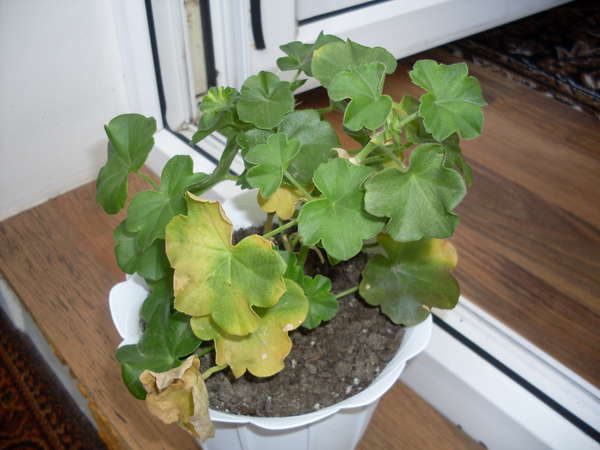

Pelargonium may react to the transplant by yellowing the foliage, this is normal, but still check the condition of the soil
But just in case, check if the soil is dry and if you are flooding the plant. Pelargonium should be watered only after the top layer has dried by 2-3 cm. For better adaptation, stimulants (Kornevin or Epin) can be added to the irrigation water.
Being able to transplant or plant plants correctly is important for a florist. Especially when it comes to flowers that do not tolerate change of place, such as pelargonium. Simple rules are easy to master. True, sometimes the florist does everything as expected, and the plant gets sick after transplanting. And the other breaks the rules, but the flower is cheerful and cheerful. What's the secret? Pelargonium lovers assure that this plant feels very well the mood and energy of a person. It is necessary to care for geraniums with love and in a good mood. So, in addition to the pot and soil, prepare a positive attitude before transplanting or grafting - then everything will work out.
Follow-up care
Geranium transplanted into a new pot does not need feeding for the first two to three months. She will take all the nutrients from fresh soil. Therefore, the geranium bush only needs timely watering as the soil dries out. It is important to ensure optimal temperature performance and proper lighting. After the appearance of new leaves and the growth of a rooted cuttings, the pelargonium is pinched so that it does not stretch up, but bush.
Read more about the proper care of geraniums here.
Why transplant
Transplanting (transshipment) of compact plants is carried out when the flower has become cramped in the old pot. This is evidenced by the roots that begin to crawl out of the ground.Due to the overgrown root system, pelargonium lacks nutrients in the soil, which may lead to its death in the future.
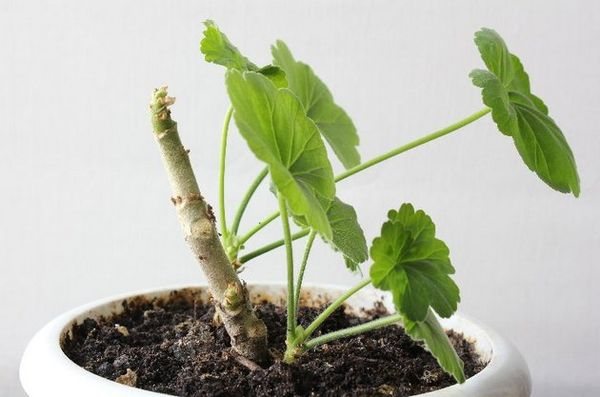

In addition, the transplant should be performed in the following situations:
- due to negligence, a lot of water was poured into the container with the flower. High soil moisture provokes root rot;
- despite full and balanced care (watering, feeding), geranium grows poorly and does not bloom;
- the shoot was exposed from below;
- soil contamination with parasites and pathogens is observed. In this case, the transshipment is of a preventive nature in order to prevent the development of the disease after geranium treatment;
- damage to the pot. It can be damaged due to physical impact (falling from the windowsill) or due to prolonged exposure to sunlight;
- depletion of the soil, which is not removed by applying top dressing. Periodically, you need to add new soil to the pot in order to naturally replenish its nutritional composition and prevent the appearance of pests;
- the need for plant propagation by dividing the rhizome.
As you can see, there are many reasons for transplanting geraniums.
Key points
Thus, we have sorted out the main aspects of transplanting indoor geraniums (read about caring for room geraniums here). Let's focus on the main points, so that your beauty continues to delight you with her healthy and bright appearance:
- The optimal time for transplanting is spring. However, if necessary, the transplant can be done in summer or autumn.
- Examine the plant to see if it really needs a transplant.
- Selecting a small pot with drainage holes.
- We use loose soil with the addition of sand and peat. We use brick chips or polystyrene as drainage.
- After transplanting, geraniums do not require watering for 2 weeks.
- Blooming geraniums can be transplanted, but recommended.
- Geranium grows well in the open field until the first frost.
We wish you success in breeding indoor geraniums!
If you find an error, please select a piece of text and press Ctrl + Enter.
About geranium
Geranium acquired an attractive appearance thanks to the work of a breeder from England, George Tradescan. For a long time, people knew about the healing properties of this flower: an ointment based on geranium juice eliminated lice, and nose drops treated colds. Even Peter I healed an ingrown nail with a plant.
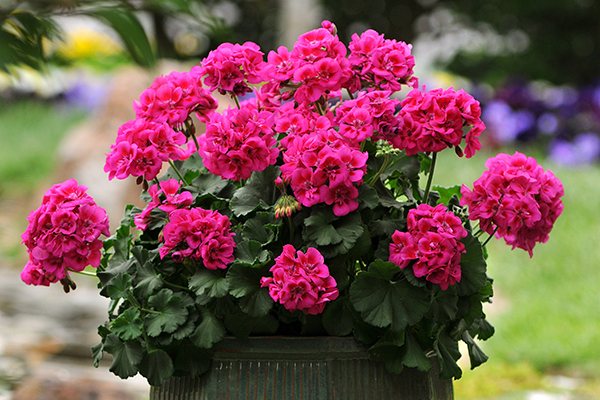

Florists love geraniums for their lush bloom. The plant is undemanding to care for. The flower perfectly cleans the air due to the special substances of phytoncides.
The healing and beneficial properties of geranium
Due to the high content of essential oils, geranium is used for medicinal purposes. Toothache or headache is treated by applying a cotton swab moistened with pelargonium oil to the inflamed area or temples. You can purify the air with essential oil and an aroma lamp.
Massage therapists apply geranium extract to massage oil to relieve muscle pain during manipulation.
CAUTION! (click to find out)
CAUTION! In addition to its medicinal properties, fragrant geranium has contraindications, therefore, a doctor's consultation is necessary before use.
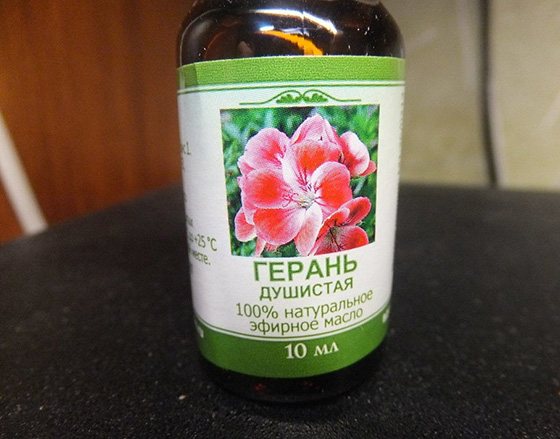

We tried to collect the most useful tips in the article. We will be glad to receive your questions and exchange of experience in growing room geraniums!
Photo
In the photo below you can see what the geranium looks like after transplanting, on the street and at home in a pot:
How to transplant geraniums into another pot
If you have already transplanted indoor geranium from one pot to another, then transplanting it from the street is no different from this procedure, which takes place in several stages:
- we prepare a container, soil and water for transplanting (it must be settled and at room temperature);
- the container for one geranium bush should be small - this is a pot 10‒15 cm high with a diameter of 15 cm.It is in small pots that the most intense flowering of the plant is noted;
- the soil can be purchased at a flower shop - this is an earthen mixture for growing geraniums, or prepared independently, consisting of 8 parts of sod land, 2 parts of humus and 1 part of sand;
- put drainage on the bottom of the pot, which can be crushed brick, expanded clay or river pebbles;
- we take a geranium bush, previously extracted from open ground, or from another pot, and examine the roots - we cut off those that are rotten or affected by pests;
- we lower the plant into a pot and pour in the substrate. We carefully compact the earth surrounding the roots, and fill up all the voids between the roots and the walls of the pot. Moreover, the ground for laying in a pot must be pre-moistened;
- water the transplanted plant and put it in a dark place for a week;
- after seven days, we place the flower in a well-lit place, where it should be constantly;
- 2 months after transplanting, you can feed the plant.
Many are interested in how often to transplant geraniums? Usually, the first transplant should be carried out in the spring 2 years after planting a young plant, and then as needed, based on the reasons mentioned above, but not more often than once a year.
Possible mistakes
The Pelargonium plant is unfriendly, but if you make mistakes when leaving, it will get sick and may die. Let's take a look at some of the most common mistakes:
- Overflowing. The leaves are willing and falling off. It is necessary to let the soil in the pot dry out, then loosen the top layer.
- The temperature is too low. The edges of the leaves turn red. Delivery of the flower to a warmer room.
- The soil is heavy. The leaf desires and falls, the root system began to rot. It is necessary to change the soil.
- The plant is infected with microorganisms. Gray spots appear on the leaves, the trunk dries. It is necessary to work with fungicides, change or sterilize the soil, remove the affected leaves.
Transplanting geraniums from a garden to a pot in the fall is a simple process. The most important thing is to follow the exact rules of the recommendation.


Pruning
Pruning is necessary to stimulate the shrub to constantly grow in width and eliminate thickening. The plant does not grow lateral shoots on its own, therefore, without forming, you can get a long branch, the leaves on which are only at the top - not very aesthetically pleasing and decorative. You can prune branches at any time of the year, even in winter:
- In the spring, the event is held before the start of sap flow in the tissues - February or early March. Geraniums will take time to recover from the procedure, but the bloom promises to be lush.
- In the summer, prophylactic cleaning of the bush from yellowed leaves, dry peduncles and branches is carried out.
- In the fall, in preparation for wintering, all peduncles are removed, long shoots without leaves are shortened, leaving cuttings 10 - 15 cm long with leaves.
In order for the bush to grow in breadth, all branches growing inside the bush are removed.
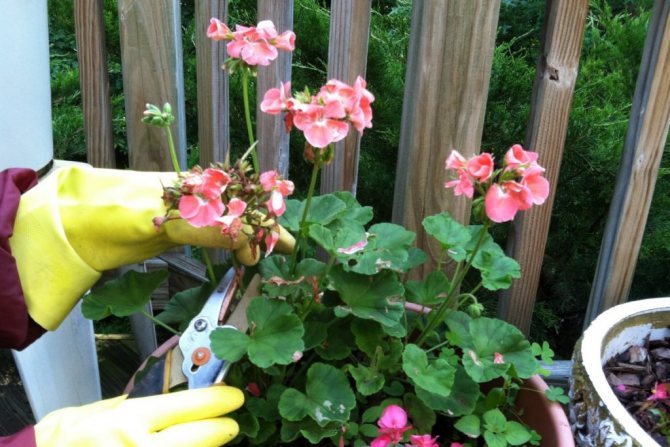

Reproduction of Pelargonium
You can propagate pelargonium at home by seeds and cuttings. Both methods are quite simple and suitable for beginner florists.
Sowing seeds is carried out in early March, and it is advisable to pre-treat the soil with a solution of potassium permanganate for disinfection. The seeds are simply scattered over the surface of the soil (it is advisable to use light and loose mixtures consisting of peat and sand), lightly sprinkled with earth on top and sprayed with a spray bottle. Further, the planting must be covered with glass or film. The container is taken out into a warm room and waiting for the first shoots to appear, daily moistening the soil and airing the garden bed.
When the first shoots appear, the shelter can be removed, and after the formation of 2-3 true leaves, the culture can be transplanted into separate containers.


Figure 8. Growing a young plant from cuttings
Reproduction by cuttings is carried out even faster (Figure 8).If you have a few shoots left during pruning, you can free them from the leaves by leaving a few in the upper part and put in water. From above, it is advisable to cover the seedling with a jar or film. When developed roots appear, the sprout is slightly dried and planted in light fertile soil.
Preparation
How to transplant geraniums at home? There are no special means to mitigate the effect of the transplant on the plant. You just need to choose the right time. As already mentioned, the plant cannot be transplanted in winter and during flowering.
The day before the procedure, the flower should be watered, as the soil must be moist. In this case, it will be easier to remove the flower with roots from the pot. Some growers recommend the use of growth stimulants that provide a quick recovery after a change of "place of residence".
Popular varieties and types
Despite the juicy green color of the leaves, the most attractive feature of the plant is its bright inflorescences. Geranium does not have red flowers, while for pelargonium it is the preferred color.
In specialized stores, you can find plants with variegated leaves and inflorescences, obtained by crossing different species.
The most popular are the following varieties of pelargonium.
- Royal... One of the first varieties used in Europe to decorate flower beds was royal pelargonium. She has large double flowers, on the petals of which a dark spot is noticeable.
- Zonal... The most famous variety of indoor geranium, distinguished not only by lush flowering, but also by the variegated color of the leaves. There are varieties with tricolor leaves, but more often they have a burgundy, silver or blue border. Flowers can be regular, semi-double and double.
- Fragrant... The name demonstrates the main feature of scented pelargonium - its feathery leaves exude a strong and pleasant scent of lemon and mint. Breeders have added notes of apples, ginger and even pine to them. These plants most often have pink and lilac flowers.
- Angel... Flowers of this variety resemble pansies and are purple, white and pink. There is also a two-tone color or petals with contrasting spots.
- Lemon... Lemon Pelargonium has unusual leaves. They are of complex shape, excised, due to which they seem terry. When touched, they emit a strong lemon scent that relieves migraine pains and calms the nervous system.
- Ivy... This geranium is often planted on balconies as it hangs beautifully from boxes and blooms throughout the warm season. Small leaves compensate for the large number of shoots and large inflorescences.
Indoor geranium - plant features
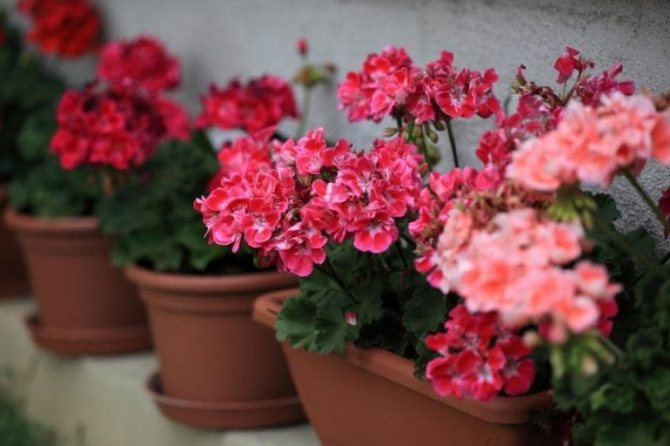

Geranium grows in all corners of the globe, taking root both in the mountains and in tropical forests. It is found in the Caucasus, but South Africa is considered the home of the houseplant. Sailors brought it to Europe in the 18th century, and geranium immediately won the attention of European aristocrats who have gardens.
The flower arrived in Russia a century later and at first was available only to wealthy people. Over time, the exotic plant became affordable and settled in almost every home.
The shape of the leaves varies greatly from species to species. They may resemble the palm of a person or have sharp points. The most popular type of indoor plant is called pelargonium.
It is this species of the geranium family that arrived from a hot continent, therefore it prefers warm and dry air. In winter, it needs additional lighting due to the short daylight hours, but a humidifier is not needed.
Like other indoor plants, pelargoniums are comfortable at a temperature of 20-25 ° C. In height, it reaches from 15 cm to 1.5 m.
Florists also appreciate the beneficial properties of geraniums. The scent of the leaves soothes the nervous system and relieves stress. A flower growing at home effectively disinfects the air, destroying viruses and microbes.
The beneficial substances and compounds contained in the leaves allow you to treat bruises, swelling, joint pain and colds with geranium essential oil. The only serious contraindication is the use of medicinal products based on the plant on an empty stomach.
Useful qualities of the plant
The main benefit in everyday life is air disinfection. The flower will take 4 hours to eliminate all odors, kill pathogenic bacteria in the air. Geranium is also used:
- for obtaining oil, aromatic additives;
- leaves are used for compresses for radiculitis, headache, gout;
- to increase blood pressure, breathe the aromas of flowers;
- the plant must be planted to protect the house from staphylococcus, streptococcus.
Traditional healers advise putting dried flowers under the pillow - this will improve sleep. And the witches say that the geranium in the house protects its inhabitants from evil intentions, slander and damage.
Geranium - description
The plant, which is commonly called geranium, is actually pelargonium. She belongs to the geranium family. The name "Pelargonium" is translated from Greek as "Stork", because of the similarity of its fruits to the beak of a stork.
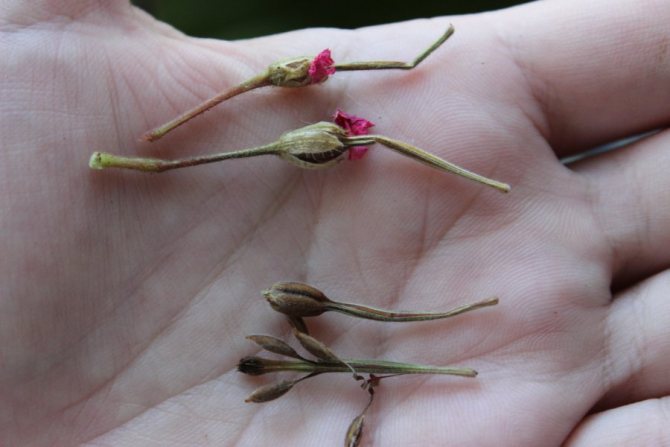

Pelargonium fruit resembles a stork's beak
Real geranium is a plant that can often be found in forest or meadow areas. There are bred varieties for garden cultivation that winter well without shelter.
Some types of geraniums in the photo


Georgian
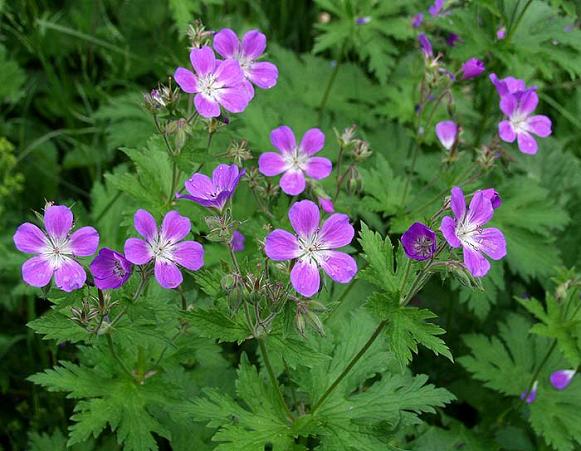

Meadow
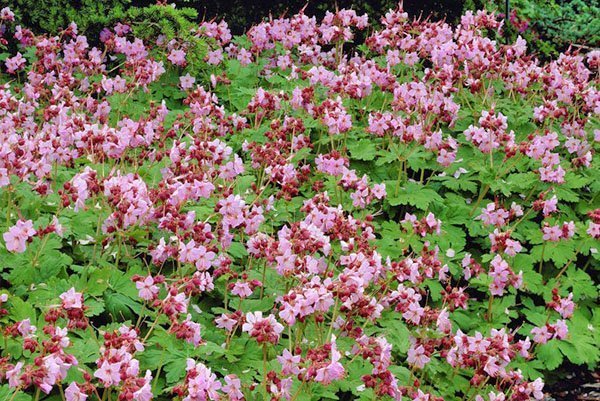

Balkan
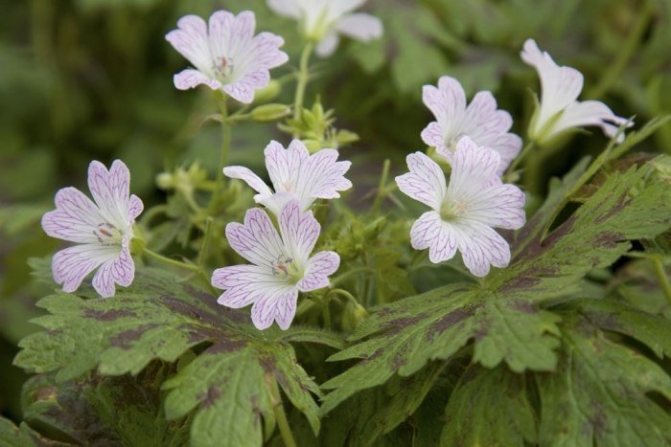

Katarina Adele


Oxford
Geraniums grow very quickly. Most species can be grown from seeds. With autumn-winter sowing, they bloom in the first year.
The geranium family unites 5 genera and 800 plant species. Geranium leaves are beautifully carved, in many species they are fragrant. Leaf colors: green, variegated, with yellow veins, with red and yellow tints.
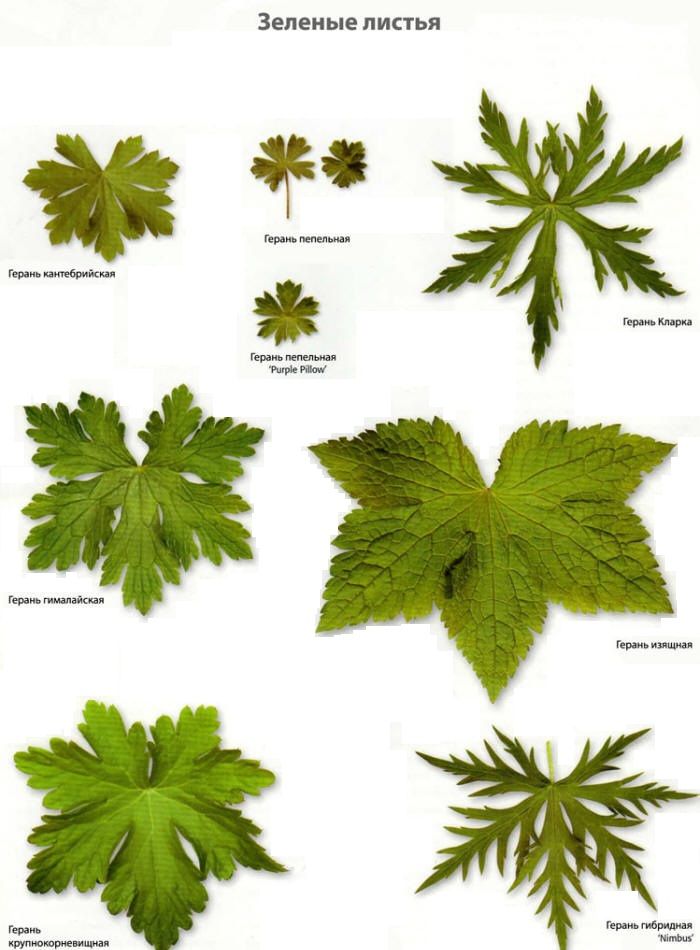

Green leaves of different shapes
Geraniums are an excellent antiseptic, have anti-inflammatory and other medicinal properties. Various extracts and essential oils are made from them.
It is very useful to keep pelargoniums at home, they disinfect and purify the air, and also scare away flies, moths and mosquitoes. Aromatic leaves can be added to tea (dry).
The smells of such fragrant geraniums are so diverse that they can resemble anything: an apple, a rose, citrus fruits, conifers, caramel, pineapple, coconut, wormwood, and so on! Most of them do not bloom as brightly as other pelargoniums, but more than make up for this deficiency with their unique and healthy aromas.
Indoor pelargoniums are mainly divided into four types: zonal, thyroid (ampelous), royal (large-flowered), fragrant (aromatic). There are a large number of varieties and hybrids of pelargonium.
Pelargonium - gallery
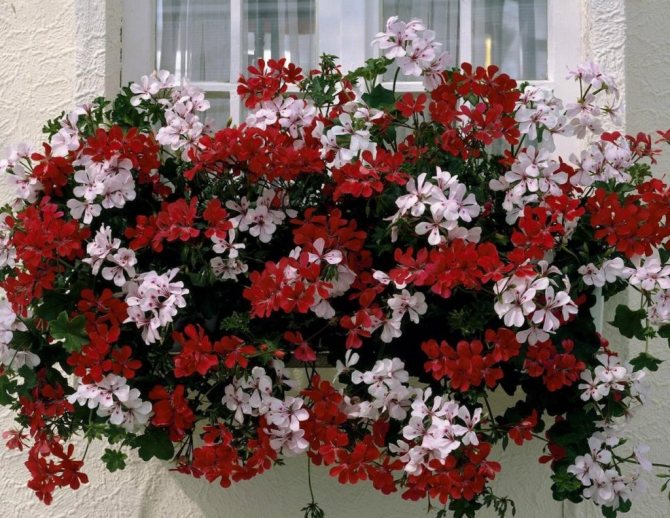

Ampel pelargoniums can be kept outdoors in summer
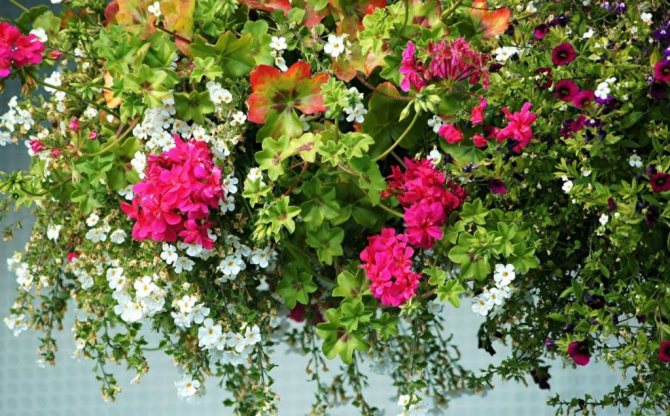

Thyroid pelargoniums look great in hanging pots along with other ampelous plants
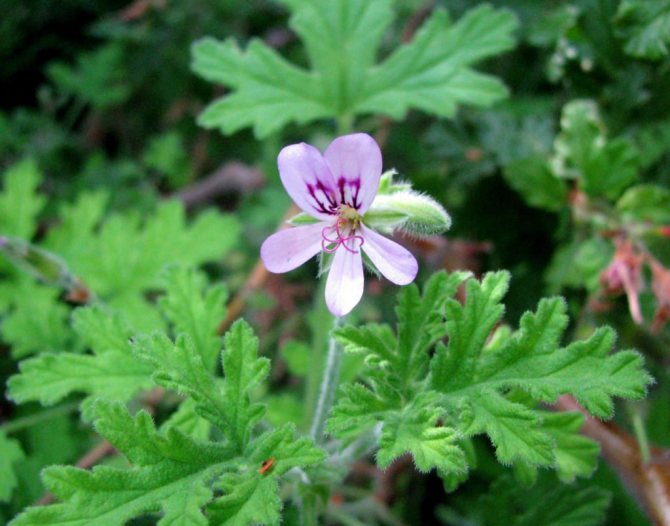

Pelargonium Aromatic with a pink-mint scent
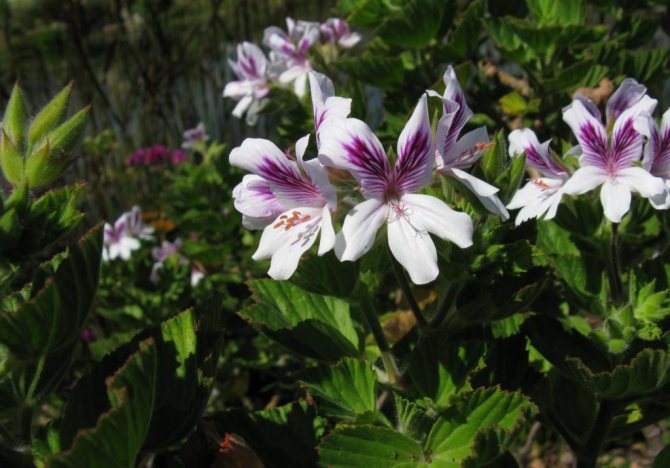

Pelargonium Klobuchkovaya with lemon scent


Zonal pelargoniums are distinguished by dense caps of inflorescences
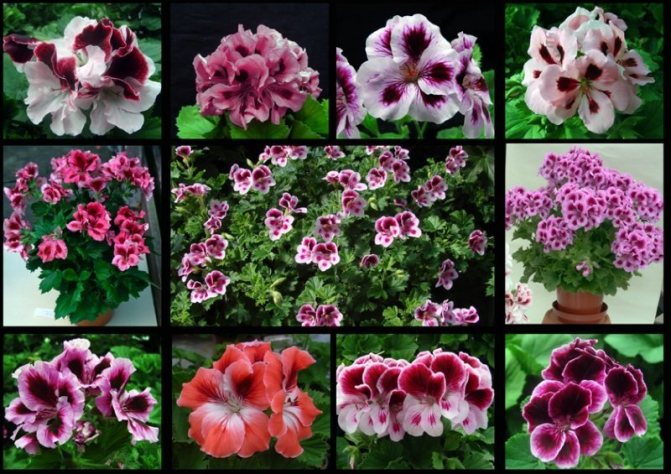

Royal Pelargonium has large flowers
Flowering problems and diseases - table
| Problems | The reasons | Elimination |
| The flowering has ceased, the leaves are withering. | Poured the soil; little light. | Check the condition of the soil, dry until completely dry. Then remove the clod with the plant from the pot and examine the roots. If necessary, remove rotten roots, treat with Fitosporin solution and transplant into new soil. If there is a lack of light, rearrange the flower to the brightest place or provide additional lighting with lamps. |
| Leaves and twigs began to wither and turn yellow. | Disease, pests. | Check the condition of the roots and the presence of pests. Treat the plant and soil with drugs. For example, Fitolavin, Fitosporin, Fitoverm.If root rot is found, replace the soil, cut off diseased roots. |
| Spots on the leaves. | Viruses; fungi. | Remove all diseased branches and leaves. Treat the plant and roots with Phytolavin and Alirin-B. |
| The lower leaves turn yellow, starting with drying out of the edges. The flowers dry up. | Lack of moisture in the soil. | Spill the soil in two steps. Once well moistened all the ground, after a while again. Drain the remaining water from the sump. |
| Lack of flowering | Too warm wintering, illness or lack of pruning. Perhaps overfed or too large a pot. | If the plant is healthy, take it to the loggia, at a temperature of at least 10 degrees. Bring it into the house at night. When blooming, it is advisable to leave the plant on the windowsill. You can pinch the upper parts of the branches. You can check the filling of the pot with roots after the earthen coma dries. Remove the plant from the pot: if the roots are not visible, or the soil is crumbling heavily, then the plant needs to be transferred to a smaller pot. |
| Rusty spots on the leaves, their fall. Blotches on flowers. | Fungus. | Treat with fungicide. After a week, treat with another fungicide. In this way, process 4 times. |
| The trunk is stretched out, flowering is poor. | Little light. | Place the flower in the brightest spot. Prune in the fall. |
Necessary conditions for treatment:
- during treatment, it is necessary to cut off all inflorescences so as not to deplete the plant;
- feed pelargonium with a complex fertilizer with the addition of an immunostimulant (Epin. Zircon): 8 drops of a stimulant per half a liter of water with fertilizer;
- water the plant only after the soil dries out;
- provide bright light, keep away from drafts, hot and humid places.
Yellowness
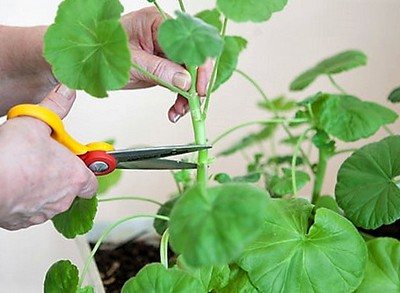

Yellowness on geraniums appears for a number of reasons:
- If only the edges of the leaves turn yellow, then the plant experiences a lack of moisture;
- If the leaves turn yellow and wither, then there is too much moisture;
- After yellowness, the leaves fall off, which means there is not enough light;
- It is necessary to check if there is enough space in the pot for her;
- Getting used to a new place or transplanting.
If the tips of the geranium leaves begin to dry out, then the plant receives very little moisture. The second reason why the edges can dry is fungal disease, rust. The leaves begin to become covered with red spots, then dry and fall off. In order to avoid wilting of geraniums, it is necessary to spray it with a solution of Bordeaux liquid 5%.
Watering and feeding
How to properly care for a flower? The incredible beauty of the royal pelargonium loves watering in large quantities, especially during the flowering period. It can be carried directly into the ground. However, it is not recommended to allow long stagnation of moisture or drying out of the soil.
Advice! Leaves and buds may wilt and begin to crumble. If too much waterlogging is allowed, the roots may dry out. Water the plant as soon as the soil dries up.
Like geraniums, royal pelargonium will bloom and grow well if feeding is done in a timely manner. For this in spring and winter, liquid fertilizers are used, which contain a large amount of potassium.
Plant diseases - what to do
Even the most unpretentious plant can be subject to pests or diseases:
- often mold or gray rot appears on the leaves - signs of over-watering. Removing damaged leaves and treating with antifungal drugs will help save geraniums;
- root rot manifests itself in root rot. You can try to cut off such roots and also treat with antifungal compounds, but most often the result is sad;
- powdery mildew leaves a whitish coating on the leaves and appears at low temperatures and high air humidity, you need to use the appropriate means;
- blackleg most often affects the cuttings, causing them to rot. Antifungal agents are needed;
- aphids and whiteflies settle on the lower part of the leaves, to remove them, the indoor flower is treated with special poisons, or folk recipes are used from pests.
To prevent the appearance of diseases and pests, it is important to take good care of the geranium and note the condition of the plant. Sluggish leaves of a dull hue indicate an excess of water. The falling of the lower leaves indicates a lack of light.
When transplanting geraniums into a pot in a house in the fall, it is important to carefully examine the plant - in a flower bed in open ground, it can be exposed to pests.
To effectively treat geraniums, it is important to correctly distinguish between disease and lack of moisture or nutrients in order to take appropriate action.
If the leaves turn yellow
Most often, flower growers are faced with the fact that geranium leaves turn yellow. This is due to insufficient watering. Either the plant is watered often, but little, as a result of which the earthen lump is simply not saturated with water, or it is rarely watered, but a lot - and the water quickly evaporates, drains through the drainage holes.
Watering should be such that the earthen lump is well moistened, but the water does not remain on the surface of the earth. When the surface of the ground becomes slightly dry - crumbly, but not completely dry - you need to water again.


If geranium does not bloom
Most often, geraniums do not bloom due to a large pot, or due to a lack of nutrition. Sometimes, on the contrary, the plant needs to reduce feeding so that it ceases to "fatten" and build up green mass. It is necessary to exclude nitrogen fertilizers for a while.
Winter care should include low temperatures and less watering. If you light up the geranium in winter, it will bloom, but in the spring it will no longer bloom. Winter is a time of rest and accumulation of strength. Pruning should be done in February.
Spring care includes switching to another watering regime - frequent, increasing room temperature and more lighting, mandatory feeding.
When planning to grow geraniums at home, it is important to remember that it is considered a poisonous plant, and it is undesirable to place a flower pot in a nursery or in the access zone of pets. A good advice for placing geraniums is an insulated loggia!
Stages
Pot selection
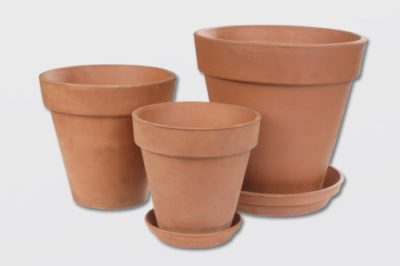

A large volume of geranium substrate is not needed, for the first planting, a pot 10-12 cm in diameter is quite suitable. With each subsequent transplant, the container must be selected 2-3 cm larger than the previous one. A pot that significantly exceeds the size of the root system will sooner or later lead to waterlogging of the soil, which can cause the death of the plant.
In a ceramic pot, geranium will feel better than in a plastic one. Clay is able to remove excess moisture and salts from the soil, which will best affect the growth of the plant.
Substrate making
Geranium is one of the most unpretentious plants when it comes to the quality of the soil, it can grow in both ordinary garden soil and in a universal substrate for flowering plants. There are also special mixtures, here are some formulations:
- humus, sod land, river sand in a ratio of 2: 2: 1;
- garden soil, peat, sand in equal proportions;
- turf land, leaf land, peat, sand in equal proportions.
Before transplanting a plant into a new substrate, it must be sterilized. This will help avoid various diseases and pests.
Plant preparation
There are no specific ways to facilitate geranium transplantation. The main thing is to choose the right time (you cannot transplant in winter and at the time of flowering). The day before, the plant must be watered abundantly so that the substrate is completely saturated with moisture - this will make it easier to remove the flower from the pot. You can also use growth stimulants as an additional guarantee that the geranium will recover successfully.
What is the difference between geranium and pelargonium?
Despite the external similarity, it is impossible to cross pelargonium and geranium, since the plants have a different genetic code.The main difference between geranium and pelargonium is that it can be grown in the garden. She is not afraid of a slight cold snap at night, while her thermophilic relative feels good only on a warm windowsill in the apartment. Geranium flowers come in different colors, and in pelargonium there are no inflorescences of blue shades. They are usually pink, red, or white.
The similarity of the two colors is that they are representatives of the Geraniev family. In both varieties, the configuration of the seed capsule resembles a beak. There are similarities between erect stems and their hairy cover. Both species have a characteristic odor and are considered medicinal.
Air, light and moisture


Pelargonium is an unpretentious plant, so in summer it can be kept at a temperature of 18-25 degrees, and in winter conditions can be cooler - 10-12 degrees.
For long and abundant flowering, it is important to provide the plant with maximum light. You can keep it on the west, east or south windows. In addition, pelargonium will grow well in the shade.
It is not necessary to keep the air humid, and bathing and spraying in the shower can harm the plant.
The benefits and harms of pelargonium for the home
Pelargonium is a popular indoor culture that is loved and appreciated by many flower growers. In addition to its decorative qualities, the shrub has medicinal properties that have found their application in folk medicine:
- Many growers grow pelargonium for medicinal purposes, because with the help of funds based on it, they treat otitis media, colds, cataracts, migraines and even depression.
- In addition, to improve overall health, it is quite enough to inhale the aroma that the shrub exudes. The essential oils contained in the plant have a beneficial effect on the human nervous system, remove fatigue and relieve stress.
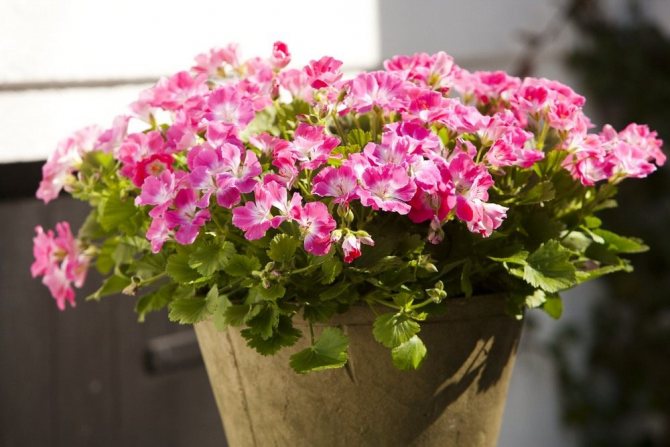

It is thanks to this property of essential oils that pelargonium is considered the keeper of the hearth and peace of mind in the house. - The flower purifies the air, which promotes sound sleep, so many growers prefer to put it in bedrooms.
- Growing Kalachik in the house will help get rid of moths, mosquitoes, flies and other pests, because the smell that it exudes repels insects.
However, when choosing a shrub for your home, you should understand that it can bring not only benefit, but also harm to its owners:
- With extreme caution, you should bring pelargonium to the home where children or people prone to allergies live. The aroma of Kalachik is a strong allergen that can provoke a runny nose, watery eyes and coughs.
- The flower pot should be placed out of the reach of animals, which can eat parts of it, as this can lead to poisoning.

